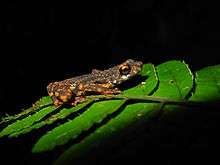Ansonia kraensis
| Ansonia kraensis | |
|---|---|
 | |
| Scientific classification | |
| Kingdom: | Animalia |
| Phylum: | Chordata |
| Class: | Amphibia |
| Order: | Anura |
| Family: | Bufonidae |
| Genus: | Ansonia |
| Species: | A. kraensis |
| Binomial name | |
| Ansonia kraensis Matsui, Khonsue, and Nabhitabhata, 2005[2] | |
Ansonia kraensis (Kra stream toad) is a species of toad in the family Bufonidae. It is found on the Kra Isthmus, Thailand.[3][4] It is morphologically similar to Ansonia malayana from Malaysia, but differs from it in ventral coloration and larval morphology.[2] The exact threats are unknown but are likely forest loss for logging and agricultural expansion.
Description
Ansonia kraensis males measure 20–22 mm (0.79–0.87 in) and females 24–28 mm (0.94–1.10 in) in snout–vent length. Tympanum is visible. Dorsum is brown with darker markings, and has small and minute warts, some of them with orange-yellow tips. Limbs have orange-yellow crossbars. Tadpoles are up to 23 mm (0.91 in) in length. Their body is flattened, dorsally black with two transverse light bands, and ventrally unpigmented. Oral disc is large.[2]
Habitat
Ansonia kraensis is a forest species found near streams, sometimes also near seepages some distance away from streams. Tadpoles have been found in a small stream with moderate flow, clinging to the rocks.[1][2]
References
- 1 2 Simon Stuart (2008). "Ansonia kraensis". IUCN Red List of Threatened Species. Version 2014.3. International Union for Conservation of Nature. Retrieved 1 March 2015.
- 1 2 3 4 Matsui, Masafumi; Wichase Khonsue; Jarujin Nabhitabhata (2005). "A new Ansonia from the Isthmus of Kra, Thailand (Amphibia, Anura, Bufonidae)" (PDF). Zoological Science. 22 (7): 809–814. doi:10.2108/zsj.22.809.
- ↑ Frost, Darrel R. (2014). "Ansonia kraensis Matsui, Khonsue, and Nabhitabhata, 2005". Amphibian Species of the World: an Online Reference. Version 6.0. American Museum of Natural History. Retrieved 1 March 2015.
- ↑ "Ansonia kraensis". AmphibiaWeb: Information on amphibian biology and conservation. [web application]. Berkeley, California: AmphibiaWeb. 2015. Retrieved 1 March 2015.
